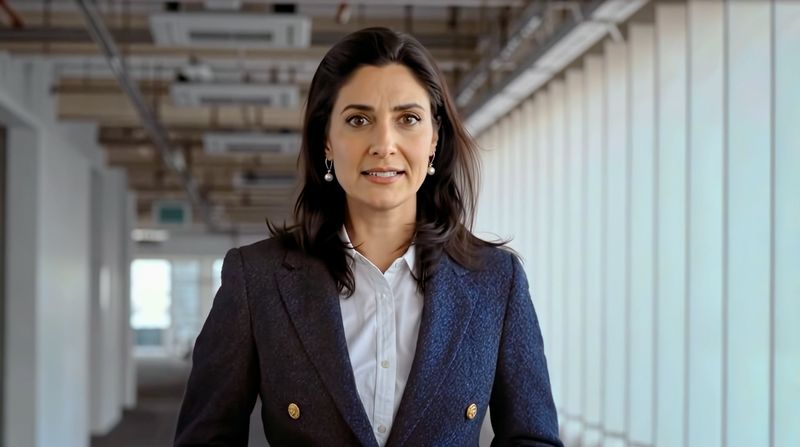EXCLUSIVE: A senior Channel 4 executive has said that the UK network is planning further AI experiments after screening a show hosted entirely by a machine-generated presenter.
Channel 4 unleashed AI journalist Aisha Gaban on Monday night in Will AI Take My Job?, but only revealed to viewers in the final seconds of the documentary that she was not a real human.
The intentionally provocative stunt was firmly within Channel 4’s remit to push creative boundaries and challenge audiences. Filmed as part of C4’s Dispatches strand, it was the network’s second most-watched show of the day, with 564,000 viewers.
Louisa Compton, Channel 4’s head of news and current affairs, told Deadline that it was “quite scary” how quickly Gaban became realistic, as producer Kalel Productions kept iterating on the presenter alongside Seraphinne Vallora, an AI marketing agency.
“This was a stunt designed to address the concerns that come with AI, how easy it is to fool people into thinking that something fake is real,” said Compton, who is leading on artificial intelligence commissioning for Channel 4 and helped draw up the broadcaster’s AI principles.
“I was actually surprised at how human she looked, how she had the odd wrinkle when she spoke, and actually how she managed to convey warmth in places.”
Did you notice anything different?
This is Britain’s first-ever AI TV presenter in a documentary. Viewers were kept in the dark until the very end. It’s part of a stunt aiming to show just how convincing AI has become, and how quickly it’s improving. pic.twitter.com/APfH4ge3U6
— Channel 4 Dispatches (@C4Dispatches) October 20, 2025
Compton said Gaban’s limitations were obvious, however. Producers were unable to recreate her sitting in a chair interviewing subjects, meaning her on-screen contributions were limited to pieces to camera. Gaban’s words were also scripted by the production team.
Others pointed out that Gaban is not about to start replacing human-led journalism. “We’re still a considerable way from AI being able to do live TV journalism,” a well-known British news anchor told Deadline, adding that it is hard to replicate the ability to “think, analyse and react” with “experience, knowledge and human empathy.”
Compton has no plans to revisit Gaban, but said that AI will continue to be woven into shows she commissions. Channel 4 has experimented with using AI to anonymise interviewees in the past, including in the two-part series Kill List: Hunted by Putin’s Spies.
Compton added that her team is also testing how AI can be used in documentary reconstruction scenes, though these have yet to screen on Channel 4.
The upsides of AI are not lost on others either — even those whose job it is to represent the interests of TV presenters. Mary Greenham, a seasoned agent to stars including Andrew Marr and Fiona Bruce through her agency NewsPresenters, said: “Do I think my presenters are at risk of losing their jobs? No.
“What AI can do is help with certain elements of production. That, in turn, will free up resources so that they can be directed towards actual frontline journalism, to uphold standards and make the editorial judgements that underpin trust.”
Compton said: “Obviously, as a journalist, there’s so much about AI that is alarming, not least the dangerous spread of misinformation. But used responsibly, ethically, and transparently, there are lots of exciting ways it can be used in productions — both on- and off-air.”
She added: “Our priority is on premium, fact-checked, duly impartial journalism, and delivering that — as well as big investigations and analysis — is something AI can never do.”
Jonathan Shalit, chairman of InterTalent Rights Group, which reps the likes of Andrew Neil and Susanna Reid, applauded Channel 4 for sparking a debate about AI presenters. “I would say to people, ‘Rather than look at AI as the enemy, look upon it as a new friend,’” he said. “It’s not going to actually replace a personality. Big stars develop a relationship with the viewers. But for a one-off stunt, it’s brilliant.”

